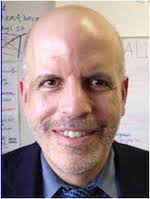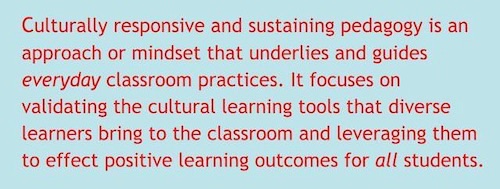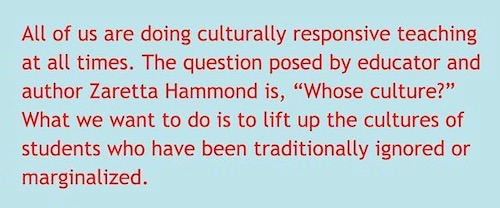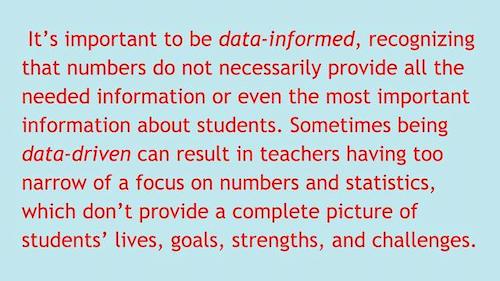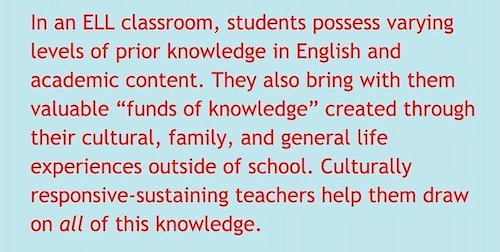Culturally Responsive and Sustaining Teaching
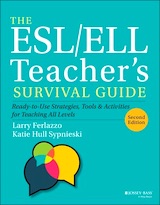 Note: This is the first of a two-part series on teaching all students in ways that are culturally responsive and sustaining – drawn from the new edition of The ESL/ELL Teacher’s Survival Guide: Ready-to-Use Strategies, Tools & Activities for Teaching All Levels by Larry Ferlazzo and Katie Hull Sypnieski. Footnotes and some references to other chapters have been deleted but can be found in the book.
Note: This is the first of a two-part series on teaching all students in ways that are culturally responsive and sustaining – drawn from the new edition of The ESL/ELL Teacher’s Survival Guide: Ready-to-Use Strategies, Tools & Activities for Teaching All Levels by Larry Ferlazzo and Katie Hull Sypnieski. Footnotes and some references to other chapters have been deleted but can be found in the book.
By Larry Ferlazzo and Katie Hull Sypnieski
There was a family that lived on the Cavally River in Liberia: a hunter, his wife, and their three sons; the mother was expecting another child soon. One morning the hunter went into the forest. Night came; the hunter didn’t come home.
A week passed. A month. The boys started hunting on their own; they did not speak about their absent father. Then, the mother gave birth to a daughter. Time passed. The baby girl learned to crawl, to stand up, to walk, and then to speak.
Her first words were “Where is my father?”
“Yes,” said the first brother. “Where is he?”
“We should find out what happened to him,” said the second brother.
“Let’s go!” said the third brother.
The first son had a sixth sense that allowed him to find their father’s body in the forest; a wild animal had killed him. Only his bones were left. The second son knew a magic spell to put flesh back on their father’s bones. The third son had the power to breathe life back into their father’s body. Their father rose up, thanked his sons, and they all went home together. The whole village celebrated the hunter’s return.
“Whom shall we honor? Who rescued this man?” the chief asked.
The sons began arguing. “I found him!” “I put flesh on his bones!” “I breathed life into his body!”
The villagers also began arguing. The chief could not decide which son to honor.
Then the mother stepped forward. “Our daughter deserves the honor,” the mother proclaimed, “because she noticed that her father was missing and asked: Where is my father?”
Everyone agreed with the mother’s verdict, and they honored the wise little girl.
Noticing What Is Missing
As this folktale teaches, each person has a valuable contribution to make, and sometimes the most important contribution is to notice what is missing. What is often missing from instruction in our schools is acknowledgement and celebration of our students’ identities and cultures.
While the majority of students in US public schools are students of color from linguistically and culturally diverse backgrounds, the vast majority of educators (around 80 percent) in K-12 public schools are white. Many students have been harmed by pedagogy that has not acknowledged systemic racism, and educators play an important role in either addressing or not addressing these harms. In light of increased public attention to police violence against people of color and a counter-reaction by conservatives opposing anti-racism teaching in schools, educators should be intentional in addressing their own biases and practicing culturally responsive and sustaining teaching.
While we are singling out this aspect of teaching multilinguals, we in no way want to imply that culturally sustaining teaching is optional or that it occurs only on certain days or in certain activities. As we will describe, culturally responsive and sustaining pedagogy is an approach or mindset that underlies and guides everyday classroom practices. It focuses on validating the cultural learning tools that diverse learners bring to the classroom and leveraging them to effect positive learning outcomes for all students.
What is Culturally Responsive and Sustaining Teaching?
Culturally responsive teaching (CRT) and culturally sustaining pedagogy (CSP) are two of the most-common philosophies guiding how teachers of all races can be better teachers to students of color. These approaches are built on the foundational work of educator and researcher Dr. Gloria Ladson-Billings. She introduced the term culturally relevant pedagogy to describe a teaching approach centered on engaging learners whose experiences and cultures were often viewed through a “deficit” lens and traditionally excluded in mainstream educational settings.
Geneva Gay expanded on the work of Ladson-Billings and identified the term culturally responsive teaching to describe pedagogy that uses “the cultural knowledge, prior experiences, frames of reference, and performance styles of ethnically diverse students to make learning encounters more relevant to and effective for them.”
Culturally sustaining pedagogy is a more recent perspective that builds on the tenets of culturally responsive and relevant teaching. This approach was first proposed by professor Django Paris, who defines it as a pedagogy that “seeks to perpetuate and foster – to sustain – linguistic, literate, and cultural pluralism as part of schooling for positive social transformation and revitalization.”
In other words, this approach prioritizes making sure that our educational practices not only respond to the diversity of languages and cultures in our classroom, but also that they aim to sustain these elements at the center of teaching and learning. As Zaretta Hammond, educator and author of the book Culturally Responsive Teaching and the Brain, points out: all of us are doing culturally responsive teaching at all times. The question posed by Hammond is, “Whose culture?” What we want to do is to lift up the cultures of students who have been traditionally ignored or marginalized.
Viewing English language learners through an asset, not deficit, based lens guides all that we do in the classroom. Instruction that is culturally responsive and sustaining explicitly challenges the deficit perspective. We believe that recognizing, validating, and using the many linguistic and cultural tools that ELLs possess ultimately provides the best learning experiences for our students and for us.
The Organizing Cycle
In our new book we discuss how the Organizing Cycle (based upon successful strategies used by community organizers) can be applied as a helpful framework for making learning more accessible to ELLs and to all learners.
These same research-based principles of building student relationships, accessing prior knowledge (particularly through student stories), developing student leadership potential, learning by doing, and reflection can also work as a frame for discussing culturally responsive and sustaining pedagogy in the ELL classroom.
Below (and in Part 2 of this article) we offer ideas and practices for each principle of the Organizing Cycle. While these elements don’t cover every aspect of culturally responsive teaching, they do represent foundational best practices we use in our classrooms.
We hope our discussion here can spur continued research and deepen learning in your own practice. And again, we want to emphasize culturally responsive and sustaining teaching is not a “program” or list of strategies. It is a mindset that influences everything we do in the classroom.
Building Strong Relationships
Many educators view positive relationships with students as a classroom management tool. However, a culturally responsive, sustaining educator views these relationships as a critical foundation of learning.
Zaretta Hammond explains the connection between our brain’s ability to learn and positive relationships: “The oxytocin positive relationships trigger helps the amygdala stay calm so the prefrontal cortex can focus on higher order thinking and learning.” To put it simply, positive relationships in the classroom help students to feel safe. When they feel safe, they can better learn. In an ELL classroom that is culturally responsive and sustaining, building positive relationships can involve:
►Taking the time to listen and to learn about our students through the relationship building and sustaining activities. We share many resources for doing this in Chapter Two of our book.
►Gathering information about students from the school (English Proficiency Level, home language survey, health information, transcripts, assessments, and so on). This data can provide context for conversations with students and their families. However, it’s important to be data-informed, recognizing that numbers do not necessarily provide all the needed information or even the most important information that teachers want to know about their students. Sometimes being data-driven can result in teachers having too narrow of a focus on numbers and statistics, which don’t provide a complete picture of students’ lives, goals, strengths, and challenges.
►Learning about students’ home countries – current conflicts/issues, specific information on the city or region they come from, language(s) they speak, etc. – from students, their families, and your own research.
►Becoming familiar with the neighborhoods students currently live in can make it easier for teachers to connect students’ daily experiences to the classroom and develop deeper relationships with students and their families.
►Gathering information on students’ academic strengths and challenges through discussions with students and their families (We like to ask parents: “What is something that has helped your child learn best?” “When has your child been most successful in school and what contributed to that success?”), regular check-ins, and close observations of students and their work.
►Giving surveys to students asking about their interests, goals, and feedback on the class can strengthen relationships if the teacher acts on this information. Asking students to fill out a Google form and then not acting on any of the feedback from students can be perceived as “performative” and can lead students to believe that the teacher doesn’t really care about them or what they think.
►Using the establish, maintain, restore framework, which has been found by researchers to be one of the most effective techniques for positive relationship building. This relationship framework involves first establishing positive relationships at the beginning of the year using strategies like the ones we describe in Chapter Two.
►Positive, trusting relationships must then be maintained throughout the year by continuing to implement those strategies and being mindful of positive and negative interactions with students (research shows teachers should aim for a five-to-one ratio).
►When negative interactions do happen, then relationships must be repaired or restored. Some of the ways teachers can help restore positive relationships include admitting their own mistakes, taking responsibility for their actions, apologizing when needed, not blaming students when things go wrong, allowing students to have a “fresh start” each day, asking students what they need to move forward, and showing empathy. It can also be important to remember that when we are apologizing to students, we want the focus to be on the student – how they are feeling, how the mistake affected them, or what they need to move forward.
►We can’t say it enough times: taking the time to learn how to pronounce each of your student’s names is essential to relationship building, and if you get it wrong, keep trying until you get it right!
We understand that many of these relationship-building activities can be challenging when the teacher doesn’t share the same home language as the student. We encourage you to see the Tech Tool in Chapter Two “Online Resources: Translating” for translation resources.
Accessing Prior Knowledge (Especially Through Stories)
Research on the brain confirms it is easier to learn something new when we can attach it to something we already know. For ELLs in particular, activating prior knowledge, also known as activating schema, plays a big role in promoting their academic literacy.
In an ELL classroom, students possess varying levels of prior knowledge in English and academic content. They also bring with them valuable “funds of knowledge” created through their cultural, family, and general life experiences outside of school.
Culturally responsive-sustaining teachers of ELLs honor their students’ experiences and understandings. They help students draw on their prior knowledge, including those outside funds of knowledge, in order to make connections to new learning.
Once teachers elicit from students what they already know and have experienced about a topic or concept, they can then decide how much additional background knowledge is needed for students to understand new content.
In Chapter Seven of our book, we include specific examples of eliciting and building background knowledge with ELLs. Here are a few more ways we support students to share and build upon their knowledge and experiences in culturally sustaining ways:
►Listening, listening, and more listening! Teachers can’t help students access and expand prior knowledge if the teacher is doing all the talking. Sometimes teachers leave out the “accessing prior knowledge” stage and move straight to “building background knowledge” by explaining every word, concept, or topic to their students. Not only can this be confusing and overwhelming for students, but it devalues students’ prior knowledge and experiences. In addition, teachers should remember that students may possess an understanding of a concept that is “different” from the teacher’s prior knowledge as opposed to “incorrect.” For example, asking students from different cultural backgrounds to write what they know about healthcare and medicine may elicit very different responses from one written by the teacher.
►Using what we call “brain sparks” to get students thinking, talking, writing, and sharing about a topic or concept we will be teaching. When starting a new unit, text, or concept, we often show students a related video (possibly at a reduced speed and certainly with English subtitles), an image, a slideshow, or other visual and ask them questions like “What do you notice?” “What do you find interesting?” or “What does this remind you of?” Simply asking students to write or talk about it with a partner can gauge prior knowledge, build background, and generate interest. Newcomers can respond in their home language or even through drawing pictures of what they already know about the topic.
►Validating and encouraging students’ use of their home language when activating and building prior knowledge (including providing texts in their home language on the topic of study). This perspective is also known as translanguaging where students are encouraged to leverage the linguistics tools of all the languages they know in order to develop their home and second (or maybe their third, fourth, or even fifth) language, content, academic, and social skills.
►Encouraging students to frequently share their cultural and linguistic knowledge with each other. This sharing can happen more formally through projects or student presentations where students teach each other about their home cultures and their home languages. Even simple, informal practices like asking students to come to the board and translate a key vocabulary word into their different home languages (followed by the teacher attempting to say the word in each language) can instantly be affirming and inject some humor (at the teacher’s expense!) into the lesson.
Providing space and time for students to consider and share the different ways they solve problems, how they might approach an activity, what works/doesn’t work best for them when learning, the similarities and differences of their home languages, and many other forms of prior knowledge and experience can help teachers create what Zaretta Hammond calls “cognitive hooks” between students’ valuable funds of knowledge and academic content.
In Part 2 Larry and Katie explore these topics:
► Identifying and Mentoring Students’ Leadership Potential
► Having Students Learn by Doing
► Questions to Promote Teacher Reflection
► Where to Find More Resources on Culturally Responsive and Sustaining Teaching
NOTE: This post is adapted from The ESL/ELL Teacher’s Survival Guide: Ready-to-Use Strategies & Activities for Teaching All Levels (2nd Edition). Links to all the online activities shared in the book can be found at the publisher’s book page. Click here and then click on Downloads under the Product Overview at the left to find the free DOWNLOAD links for all the Exhibits, Figures and Bonus Chapters. It’s a true treasure! Many materials mentioned by chapter in this post can be found.
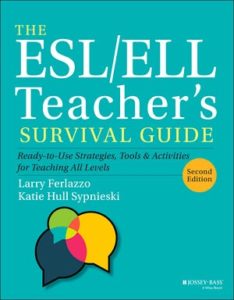
Katie Hull Sypnieski teaches English Language Learners and English-proficient students at Arthur A. Benjamin Health Professions High School in Sacramento, California. She is a Teacher Consultant with the Area 3 Writing Project at the University of California, Davis and is a co-author of The ELL Teacher’s Toolbox and Navigating the Common Core with English Language Learners.
Larry and Katie are co-authors of the 1st and 2nd editions of The ESL/ELL Teacher’s Survival Guide: Ready-to-Use Strategies, Tools & Activities for Teaching All Levels (Wiley/Jossey-Bass, 2022).

